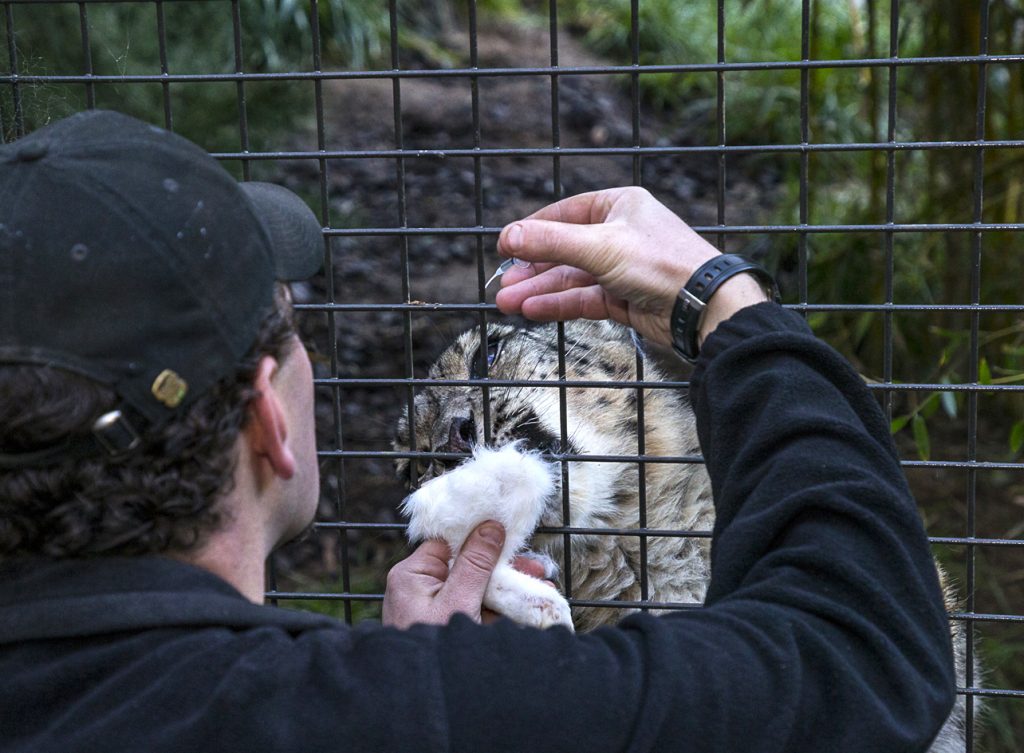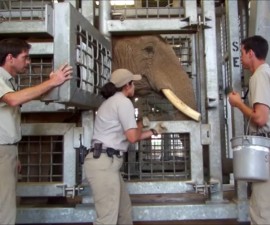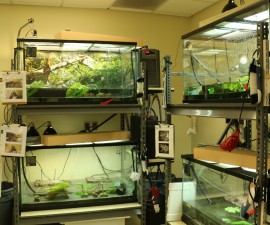“It’s like herding cats”- is a common phrase used to describe a difficult or impossible task. As the primary keeper for the Asian Leopard Exhibit at the San Diego Zoo, it could also be used to describe my work day. From moving cats off exhibit so we can clean to performing medical procedures there are many things I have to do to ensure the health and well-being of our leopards, all I have to do is to get their cooperation.
The way we manage our leopards—and all animals at the San Diego Zoo—is based on positive reinforcement. Basically, do something we ask and receive a reward. For these felines the reward consists of some sort of delicious treat, maybe a piece of beef heart or a leg of rabbit. Over several repetitions they learn that a certain behavior gets a certain reward. Below are some examples of some cool training we’ve accomplished with our leopards.

I’m sure many cat guardians out there have struggled getting their house cat into a carrier for a routine vet visit. To most folks, getting a 100-pound leopard in a crate might sound insane, but this was just the challenge we faced when moving the cats out of the old Big Cat Trail to make way for the construction of Africa Rocks. What we did was set up the crate and rewarded the cats with a treat any time they calmly entered. For some of our braver cats, like the Amur leopards, as soon as they made the connection they would eagerly wait at the crate door for us to open it so they could step in and receive their snack. The snow leopards are much more sensitive, so it was a slower process. However, once moving day came each and every cat calmly entered their crate for the short move to their new home.
Now imagine getting eye drops at an eye exam. Probably not something you look forward to all year, right? Another challenge we faced was when receiving our male snow leopard, Ramil. The excitement over the potential of having a breeding pair of snow leopards was slightly dampened when we found out that Ramil had a medical condition which required him to receive up to three eye drops a day. Coincidentally, I had been having some eye issues of my own and was having a hard enough time giving myself eye drops, so it was difficult to imagine how we were going to accomplish this with a snow leopard. Fortunately, Ramil is pretty compliant; when we call his name, he comes over and even tilts up the eye that needs the drops. Kudos go to the keepers at his former zoo. They established the behavior so well that it took only a little time to get Ramil used to his new surroundings and keepers before he was regularly accepting his eye drops.

Ramil’s eye condition included glaucoma—a progressive disease. The eye drops were part of the treatment we gave him to eliminate the pain and slow the progression of the disease. Recently veterinarians and keepers determined that the treatments had become less effective and that the glaucoma had reached an end stage. The only way to fully relieve Ramil’s pain was to remove the eye. He has since recovered and adapted to his “new normal” amazingly quickly. The day after his exam he was moving and climbing around with just as much agility as he did with both eyes!
At both the Zoo and the Safari Park keepers train many of our animals in behaviors that allow us to provide care for them, making them happier, healthier, and stress free. For example, our two female snow leopards, Anna and Penny, are making big strides in voluntarily accepting injections. So the next time they are due for vaccinations they should be ready to voluntarily participate. Herding cats is possible with the right techniques, combined with creativity and patience. And just in case you’ve ever wondered, you can indeed teach an old leopard new “tricks”!
Todd Speis is a keeper at the San Diego Zoo. Read his previous blog, Fossa: Madagascar’s King of the Jungle.





